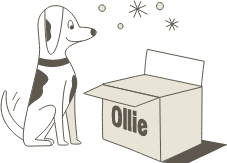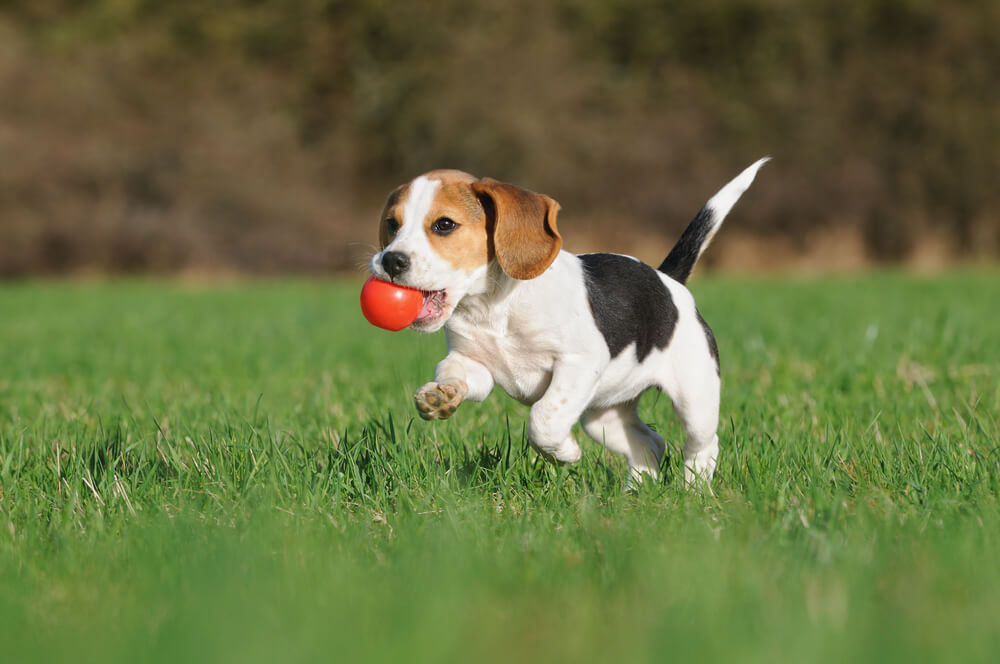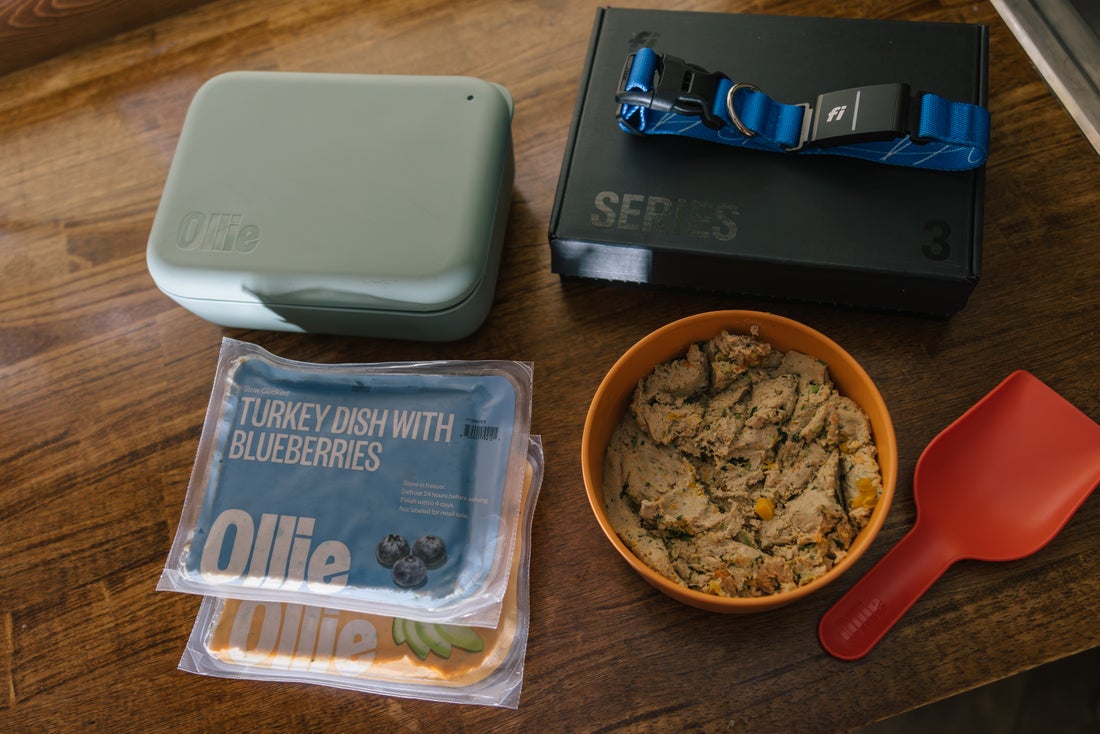Hey Ollie blog readers! We’re offering you an exclusive 60% OFF your starter box! Try now!
Your dog won’t stop scratching. Maybe it’s their ears, their paws, or a patch of skin that suddenly looks red and irritated. It’s easy to assume it’s allergies, fleas, or even dry skin. But there’s another common culprit that flies under the radar—a yeast infection.
Yeast infections in dogs are more common than you might think. And no, they’re not just limited to ears. These infections can show up on the paws, belly, underarms, neck folds, or anywhere there’s warmth, moisture, and skin.
If your dog smells a little…funky (think musty or sweet), has greasy skin, or is constantly licking the same spot, yeast might be the reason. The good news is, once you spot the signs, there are clear steps you can take to treat and prevent it.
Let’s break down exactly what’s going on when a dog has a yeast infection—and how you can help them feel better.
What Is a Yeast Infection in Dogs?
Yeast infections in dogs happen when there’s an overgrowth of yeast—specifically Malassezia pachydermatis—on the skin. Yeast is always present on your dog’s skin in small amounts, and in healthy dogs, it usually doesn’t cause any issues. But when the skin’s natural balance is thrown off, yeast can multiply fast and trigger inflammation, itching, and infection.
Yeast loves places that are warm, dark, and moist. That’s why it often shows up in ears, skin folds, between the toes, and around the groin. Dogs with floppy ears, wrinkled skin, or thick fur tend to be more prone, especially in hot or humid weather.
It’s not contagious to humans or other pets, but it’s definitely uncomfortable for your dog—and if left untreated, it can lead to more serious skin problems.
The sooner you catch it, the easier it is to treat. Up next, we’ll dig into what causes yeast to get out of control in the first place.
Common Causes of Dog Yeast Infections
Yeast infections don’t usually appear out of nowhere. They tend to show up when something in your dog’s system is out of balance. Understanding the cause helps you treat the infection—and more importantly, prevent it from coming back.
Allergies (Food or Environmental)
Allergies are one of the biggest triggers for yeast overgrowth. When your dog is reacting to something in their food or the environment—like dust, pollen, grass, or even certain proteins—the skin can become inflamed. That inflammation weakens the skin’s barrier and creates a perfect setup for yeast to multiply.
If your dog keeps getting ear infections or licks their paws obsessively, allergies may be a hidden factor. Food allergies, especially to ingredients like chicken, wheat, or soy, are more common than most people realize.
Antibiotics or a Weakened Immune System
Antibiotics can be life-saving, but they also wipe out the good bacteria that help keep yeast in check. After a round of antibiotics, some dogs develop yeast infections because the natural balance of their skin microbiome has been disrupted.
Dogs with weakened immune systems—from illness, chronic stress, or age—can also have a harder time controlling yeast on their own.
Moisture and Skin Folds
Warm, moist areas are yeast’s favorite hangouts. That’s why infections are often found in places like the ears, armpits, groin, or between the toes. Dogs with lots of wrinkles or thick coats are especially prone, and so are swimmers or those who don’t dry off completely after a bath.
Even just a little leftover moisture in the ears can lead to recurring infections—especially in dogs with floppy ears where airflow is limited.
Hormonal Imbalance or Underlying Conditions
If your dog has an ongoing issue with yeast infections, there may be an underlying medical condition at play. Diseases like hypothyroidism or Cushing’s disease can mess with hormone levels, weaken the immune system, and set the stage for chronic skin issues.
It’s worth having a conversation with your vet if infections keep coming back despite good hygiene and diet changes.
Diet and Nutrition
Yeast feeds on sugar and starch. That doesn’t mean your dog is eating donuts, but many commercial dog foods are loaded with high-carb fillers like corn, wheat, and white potatoes—ingredients that can feed yeast overgrowth.
Feeding your dog a diet that’s low in unnecessary carbs and high in quality proteins and healthy fats can help keep yeast under control. This is where nutrition really makes a difference, and where Ollie fresh food, limited-ingredient meals can help support healthy skin from the inside out.
Signs and Symptoms of a Yeast Infection in Dogs
Yeast infections can look a little different depending on where they show up, but there are some clear signs to watch for.
Common symptoms include:
- Persistent itching or chewing, especially in the same spot
- Red, inflamed, or thickened skin
- A musty, sweet, or “corn chip” smell
- Greasy, oily, or scaly skin texture
- Hair loss or patches of discolored skin
- Discharge from the ears (brown or yellowish)
- Licking or chewing the paws
- Head shaking or ear scratching
If your dog’s skin looks irritated, or if there’s a lingering smell even after a bath, there’s a good chance yeast is involved. In chronic cases, the skin can become leathery or darkened over time—especially on the paws, ears, or underarms.
Catching these symptoms early makes treatment easier and can help prevent future flare-ups.
Dog Yeast Infection Treatment Options
Once you’ve identified a yeast infection, the next step is getting your dog some relief. Treatment depends on how severe the infection is and where it’s located, but with the right approach, most dogs recover quickly.
Veterinary Diagnosis and Medications
Before starting any treatment, your vet will likely examine your dog’s skin and may take a sample (like a skin swab or tape impression) to confirm it’s yeast and not bacteria or something else. That way, your dog gets the right treatment from the start.
In moderate to severe cases, your vet may prescribe:
- Topical antifungal creams or sprays for localized infections
- Medicated shampoos that help reduce yeast on the skin
- Oral antifungal medication for widespread or chronic infections
- Ear drops if the infection is inside the ears
Always follow your vet’s instructions carefully. Skipping doses or stopping early can lead to the infection coming right back.
Cleaning and Maintenance
Keeping the affected area clean and dry is just as important as medicating it. Regular bathing with antifungal shampoos—usually a couple of times a week—can help break the yeast cycle. Be sure to rinse well and dry thoroughly, especially in skin folds and between the toes.
For ear infections, use a vet-recommended ear cleaner to gently remove buildup. Avoid using cotton swabs inside the ear canal.
Nutritional Support and Diet
Treating yeast infections topically is important—but long-term relief often starts with what your dog eats. A diet that supports immune health and avoids common allergens or yeast-feeding ingredients can make all the difference.
Fresh dog food made with clean, limited ingredients and no fillers (like wheat, corn, or soy) can help reduce inflammation and support your dog’s natural defenses. At Ollie, we build every meal around real, whole ingredients—no junk, no by-products, and nothing that feeds the problem.
Pairing a clean diet with our Skin & Coat supplement can also provide extra support with omega-3s and key nutrients to nourish the skin and reduce irritation.
Preventing Yeast Infections in Dogs
Once your dog is feeling better, the goal is keeping them that way. Prevention is all about consistency—small habits that keep skin clean, dry, and balanced.
Here’s how to help prevent future yeast infections:
- Dry your dog thoroughly after baths and swimming, especially in ears and folds
- Clean ears regularly with a vet-recommended solution, especially for dogs prone to buildup
- Groom and trim hair around the paws, ears, and other yeast-prone areas
- Feed a balanced, low-carb diet with high-quality ingredients
- Avoid excessive use of antibiotics or steroids unless necessary
- Watch for early signs of irritation or unusual smells and address them quickly
For dogs with a history of yeast infections, prevention is an ongoing routine—not a one-time fix. But with the right care and nutrition, you can greatly reduce the chances of it coming back.
Support Skin Health Through Nutrition
What your dog eats plays a huge role in how their skin looks and feels. A diet loaded with fillers, additives, or hard-to-digest ingredients can trigger inflammation, weaken the immune system, and create the perfect setup for recurring yeast infections.
That’s why many pet parents turn to fresh dog food when their dog’s skin issues won’t go away.
At Ollie, we take a clean and simple approach to nutrition. Our recipes are crafted with high-quality, limited ingredients that are easy to digest and free from common irritants like corn, wheat, soy, and artificial preservatives. We focus on whole foods that support immune function, skin health, and overall well-being.
If your dog is dealing with itchy skin, frequent ear infections, or funky paws, switching to a diet that works with their body—not against it—can make a big difference.
For added support, our Skin & Coat supplement provides omega-3 fatty acids, biotin, and other skin-nourishing nutrients to help reduce irritation and promote a healthier skin barrier.
Good nutrition is one of the best ways to help prevent yeast from taking hold again—and it starts with what goes into the bowl every day.
Healthy Skin Starts from Within
Yeast infections in dogs are frustrating—for you and your pup. They itch, they smell, and they just keep coming back if you don’t treat the root cause. But with the right care, they’re totally manageable.
Start with a proper diagnosis, follow treatment through to the end, and look closely at what your dog eats every day. Fresh, nutrient-dense food can do more than fill their belly—it can help balance their skin, reduce inflammation, and support their immune system.If your dog has struggled with chronic yeast issues, we’re here to help. Our fresh food and targeted supplements are made to support real, lasting wellness.
Tagged As:

The nutrition your dog needs,
the food they want.

Enjoying our articles? Subscribe our Newsletters and get new articles directly to your inbox
You might also like
9 October 2025
4 MINS READ
How Fresh Food Can Help Soothe Your Dog’s Allergies
As a pup parent, watching your dog suffer from the constant discomfort of allergies is always distressing. The endless scratching, irritated skin, and digestive upset can take a toll on your pup�…
by Ollie Pets
18 September 2025
4 MINS READ
Is Fresh Dog Food Easier to Digest?
Yes, fresh dog food is generally easier for dogs to digest than highly processed kibble. Because it’s made with whole ingredients, gently cooked, and free from unnecessary fillers, fresh food supp…
by Ollie Pets
18 September 2025
5 MINS READ
Can I Rotate Fresh Dog Food Flavors?
Yes, it’s safe to rotate fresh dog food flavors, and many dogs actually benefit from the variety. At Ollie, we offer multiple fresh recipes, like Beef, Chicken, Turkey, Lamb, and Pork so you can…
by Ollie Pets







